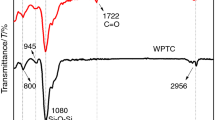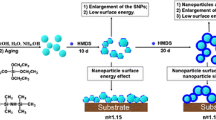Abstract
Hydrophobic surface with satisfactory resistance to ultraviolet (UV) radiation plays a vital role in sol–gel porous antireflective (AR) coatings. In this work, sol–gel hydrophobic silica AR coatings were prepared by modifying the surface of nanoparticles with fluorine-free organosilanes (hexamethyldisilazane, hexadecyltrimethoxysilane, and N-octyltrimethoxysilane) or fluorine-containing silanes (1H, 1H, 2H, 2H-perfluoroalkyltriethoxysilane and 1H, 1H, 2H, 2H-perfluorooctyltrichlorosilane). The UV resistance of the coatings grafted with different hydrophobic groups was studied through monitoring the changes in wettability and optical properties of the coatings before and after UV irradiation. In addition, the evolution in the surface characteristics of the coatings after UV irradiation was evaluated by studying their surface morphology and chemical composition. Based on the contact angle results, the surface free energy (SFE) of the coatings before and after UV irradiation was estimated and compared. After UV irradiation, the SFE of fluorine-free organosilane-modified silica coatings increases dramatically, whereas the coatings modified with the fluoroalkyl silanes still maintain very low SFE. The high bond energy of C−F provides a particularly high degree of resistance to UV light damage, which imparts the long-chain fluoroalkyl-grafted POTS/SiO2 and POTCS/SiO2 coatings with superior UV resistance. The fluorine-containing organosilane modification provides an effective way to simultaneously integrate high transparency and excellent UV resistance for hydrophobic silica coatings.

Graphical abstract
Highlights
-
The UV resistance of different hydrophobic silica antireflective coatings was studied.
-
The fluorine-containing organosilane-modified silica coating exhibits combined advantages of high transparency, UV resistance, and hydrophobicity.
-
The surface of fluorine-free organosilane-modified silica coating changes from hydrophobic to super-hydrophilic.









Similar content being viewed by others
References
Tao C, Zou X, Jiang B (2019) A hydrophobic ultralow refractive-index silica coating towards double-layer broadband antireflective coating with exceptionally high vacuum stability and laser-induced damage threshold. Colloids Surf A: Physicochemical Eng Asp 563:340–349
Zhang C, Zhao H, Su Y, Wang H, Shen J, Wang X (2022) Embedding constructed broadband refractive index graded antireflective coating with high abrasion resistance and environmental stability for polycarbonate glass. J Colloid Interface Sci 608:13–21
Wang X, Shen J (2010) Sol-gel derived durable antireflective coating for solar glass. J Sol-Gel Sci Technol 53(2):322–327
Wang X, Shen J (2012) A review of contamination-resistant antireflective sol–gel coatings. J Sol-Gel Sci Technol 61(1):206–212
San Vicente G, Bayón R, Germán N, Morales A (2011) Surface modification of porous antireflective coatings for solar glass covers. Sol Energy 85(4):676–680
Tao C, Yan H, Zhang L (2016) Sol-gel based antireflective coatings with superhydrophobicity and exceptionally low refractive indices built from trimethylsilanized hollow silica nanoparticles. Colloids Surf A: Physicochemical Eng Asp 509:307–313
Wang X, Zhao H, Cao Y, Shen J (2016) Sol–Gel preparation of laser damage resistant and moisture-proof antireflective coatings for KDP crystals. Langmuir 34(35):10262–10269
Agustín-Sáenz C, Machado M, Zubillaga O, Tercjak A (2019) Hydrophobic and spectrally broadband antireflective methyl-silylated silica coatings with high performance stability for concentrated solar applications. Sol Energy Mater Sol Cells 200:109962
Zhang Q, Wei Y, Yang W, Shen J (2015) Improvement on contamination resistance to volatile organics and moisture of sol–gel silica antireflective coating for 351 nm laser system by structural modulation with fluorinated compounds. RSC Adv 5(6):4529–4536
Pareek R, Mukherjee C, Pradeep Kumar G (2008) Effect of oil vapor contamination on the performance of porous silica sol-gel antireflection-coated optics in vacuum spatial filters of high-power neodymium glass laser. Optical Eng 47(2):023801
Jeong H-J, Kim D-K, Lee S-B, Kwon S-H, Kadono K (2001) Preparation of water-repellent glass by sol–gel process using perfluoroalkylsilane and tetraethoxysilane. J Colloid Interface Sci 235(1):130–134
Agustín-Sáenz C, Machado M, Tercjak A (2020) Polyfluoroalkyl-silica porous coatings with high antireflection properties and low surface free energy for glass in solar energy application. Appl Surf Sci 509:144864
Zhang X, Lin M, Lin L, Zhuang M, Ye L, Jiang B (2015) Sol–gel preparation of fluoro-containing ORMOSIL antireflective coating with resistance simultaneously to hydrophilic and oleophilic pollutants. J Sol-Gel Sci Technol 74(3):698–706
Hikita M, Tanaka K, Nakamura T, Kajiyama T, Takahara A (2005) Super-liquid-repellent surfaces prepared by colloidal silica nanoparticles covered with fluoroalkyl groups. Langmuir 21(16):7299–7302
Huang J, Liu Y, Cao Y, Shen J, Wang X (2019) Durable silica antireflective coating prepared by combined treatment of ammonia and KH570 vapor. J Coat Technol Res 16(2):615–622
Chi F, Zeng Y, Liu C, Ding C (2020) Aggregation of silica nanoparticles in sol–gel processes to create optical coatings with controllable ultralow refractive indices. ACS Appl Mater Interfaces 12(14):16887–16895
Li X, Shen J (2011) The stability of sol–gel silica coatings in vacuum with organic contaminants. J Sol-Gel Sci Technol 59(3):539–545
Belleville P, Floch H, Pegon M (1994) Sol-gel broadband antireflective coatings for advanced laser-glass amplifiers. Proc SPIE 2288:14–24. https://doi.org/10.1117/12.188947
Boudot M, Gaud V, Louarn M, Selmane M, Grosso D (2014) Sol-gel based hydrophobic antireflective coatings on organic substrates: a detailed investigation of ammonia vapor treatment (AVT). Chem Mater 26(5):1822–1833
Wang X, Zhao H, Cao Y, Shen J (2019) Surface free energy and microstructure dependent environmental stability of sol–gel SiO2 antireflective coatings: effect of combined vapor phase surface treatment. J Colloid Interface Sci 555:124–131
An K, Long C, Sui Y, Liu C (2020) Large-scale preparation of superhydrophobic cerium dioxide nanocomposite coating with UV resistance, mechanical robustness, and anti-corrosion properties. Surf Coat Technol 384:125312
Ghani K, Kiomarsipour N, Ranjbar M (2019) New high-efficiency protective coating containing glycidyl-POSS nanocage for improvement of solar cell electrical parameters. J Nanostruct 9(1):103–111
Yuan J, Zhang Z, Yang M, Wang W, Liu W (2018) POSS grafted hybrid-fabric composites with a biomimic middle layer for simultaneously improved UV resistance and tribological properties. Compos Sci Technol 160:69–78
Gill AK, Riyajuddin S, Alam M, Patra D (2020) Mussel-inspired UV protective organic coatings via layer-by-layer assembly. Eur Polym J 124:109455
Amrollahi S, Mohseni M, Ramezanzadeh B (2017) Fabrication of a low surface energy acrylic/melamine clearcoat with enhanced weathering and biological resistances: Investigation of the role of organic UV absorber and nanosilica particles. Prog Org Coat 105:132–142
Ren G, Song Y, Zhu X (2018) A simple way to an ultra-robust superhydrophobic fabric with mechanical stability, UV durability, and UV shielding property. J Colloid Interface Sci 522:57–62
Zhu D, Lu X, Lu Q (2014) Electrically conductive PEDOT coating with self-healing superhydrophobicity. Langmuir 30(16):4671–4677
Li Y, Li L, Sun J (2010) Bioinspired self-healing superhydrophobic coatings. Angew Chem 122(35):6265–6269
Liu Q, Wang X, Yu B, Zhou F, Xue Q (2012) Self-healing surface hydrophobicity by consecutive release of hydrophobic molecules from mesoporous silica. Langmuir 28(13):5845–5849
Puretskiy N, Stoychev G, Ionov L (2012) Surfaces with self-repairable ultrahydrophobicity based on self-organizing freely floating colloidal particles. Langmuir 28(8):3679–3682
Golovin K, Boban M, Tuteja A (2017) Designing self-healing superhydrophobic surfaces with exceptional mechanical durability. ACS Appl Mater Interfaces 9(12):11212–11223
Wu M, Ma B, Pan T, Chen S, Sun J (2016) Silver-nanoparticle-colored cotton fabrics with tunable colors and durable antibacterial and self-healing superhydrophobic properties. Adv Funct Mater 26(4):569–576
Zhao R, Chen Y, Liu G, Chen K (2018) Fabrication of self-healing waterbased superhydrophobic coatings from POSS modified silica nanoparticles. Mater Lett 229:281–285
Isimjan TT, Wang T, Rohani S (2012) A novel method to prepare superhydrophobic, UV resistance and anti-corrosion steel surface. Chem Eng J 210:182–187
Pan G, Xiao X, Ye Z (2019) Fabrication of stable superhydrophobic coating on fabric with mechanical durability, UV resistance and high oil-water separation efficiency. Surf Coat Technol 360:318–328
Zhang Y, Zhang X, Ye H, Jiang B (2012) A simple route to prepare crack-free thick antireflective silica coatings with improved antireflective stability. Mater Lett 69:86–88
Manca M, Cannavale A, Gigli G (2009) Durable superhydrophobic and antireflective surfaces by trimethylsilanized silica nanoparticles-based sol-gel processing. Langmuir 25(11):6357–6362
Wang X, Zhao H, Shen J (2019) Low-temperature preparation of mechanically robust and contamination-resistant antireflective coatings for flexible polymeric glasses via embedding of silica nanoparticles and HMDS modification. ACS Appl Mater Interfaces 11(40):37084–37093
Giasuddin ABM, Cartwright A, Jackson K, Britt DW (2019) One-step hydrophobic silica nanoparticle synthesis at the air/water interface. ACS Sustain Chem Eng 7(6):6204–6212
Zhang H, Li X, Yao Y, Ye M (2019) Sol-gel preparation of titanium (IV)-immobilized hierarchically porous organosilica hybrid monoliths. Analytica Chim Acta 1046:199–207
Lin D, Zeng X, Wu T (2019) One-pot fabrication of superhydrophobic and flame-retardant coatings on cotton fabrics via sol-gel reaction. J Colloid Interface Sci 533:198–206
Xiao B, Xia B, Jiang B (2012) Sol-gel preparation of double-layer tri-wavelength antireflective coating. J Sol-Gel Sci Technol 64(2):276–281
Qing Y, Yang C, Liu C (2016) Superhydrophobic TiO2/polyvinylidene fluoride composite surface with reversible wettability switching and corrosion resistance. Chem Eng J 290:37–44
Chi F, Zeng Y, Liu C, Pan N, Ding C, Yi F (2020) Highly stable self-cleaning antireflection coatings from fluoropolymer brush grafted silica nanoparticles. Appl Surf Sci 507:144836
Park BH, Lee M-H, Kim SB, Jo YM (2011) Evaluation of the surface properties of PTFE foam coating filter media using XPS and contact angle measurements. Appl Surf Sci 257(8):3709–3716
Wenzel RN (1936) Resistance of solid surfaces to wetting by water. Ind Eng Chem 28(8):988–994
Cassie ABD, Baxter S (1944) Wettability of porous surfaces. Transactions of the Faraday. Society 40:546–551
Lugscheider E, Bobzin K (2001) The influence on surface free energy of PVD-coatings. Surf Coat Technol 142-144:755–760
Zhao Q, Wang S, Müller-Steinhagen H (2004) Tailored surface free energy of membrane diffusers to minimize microbial adhesion. Appl Surf Sci 230(1-4):371–378
Żenkiewicz M, Richert J, Rytlewski P, Moraczewski K (2009) Some effects of corona plasma treatment of polylactide/montmorillonite nanocomposite films. Plasma Process Polym 6(S1):S387–S391
Nishino T, Meguro M, Nakamae K, Ueda Y (1999) The lowest surface free energy based on -CF3 alignment. Langmuir 15(13):4321–4323
Li X, Xu X, Truhlar DG (2016) Benchmark calculations for bond dissociation enthalpies of unsaturated methyl esters and the bond dissociation enthalpies of methyl linolenate. J Phys Chem A 120(23):4025–4036
Reinhold M, McGrady JE, Perutz RN (2004) A comparison of C-F and C-H bond activation by zerovalent Ni and Pt: a density functional study. J Am Chem Soc 126(16):5268–5276
Cao Y, Wu H (2018) A highly stretchy, transparent elastomer with the capability to automatically self-heal underwater. Adv Mater 30(49):1804602
Wiberg KB, Rablen PR (1993) Origin of the stability of carbon tetrafluoride: negative hyperconjugation reexamined. J Am Chem Soc 115(2):614–625
Wang W, Ji B, Zhang Y (2009) Chalcogen bond: a sister noncovalent bond to halogen bond. J Phys Chem A 113(28):8132–8135
Acknowledgements
This work was financially supported by National Key Research and Development Program of China (2017YFA0204600), National Natural Science Foundation of China (11874288), and Fundamental Research Funds for the Central Universities from Tongji University.
Author information
Authors and Affiliations
Contributions
The manuscript was written through the contributions of all authors. All authors have given approval to the final version of the manuscript.
Corresponding authors
Ethics declarations
Conflict of interest
The authors declare no competing interests.
Additional information
Publisher’s note Springer Nature remains neutral with regard to jurisdictional claims in published maps and institutional affiliations.
Rights and permissions
About this article
Cite this article
Su, Y., Wang, X., Zhao, H. et al. UV resistance of sol-gel hydrophobic silica antireflective coatings. J Sol-Gel Sci Technol 106, 381–392 (2023). https://doi.org/10.1007/s10971-022-05729-9
Received:
Accepted:
Published:
Issue Date:
DOI: https://doi.org/10.1007/s10971-022-05729-9




